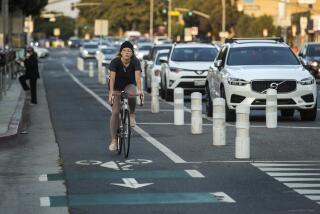Pedal-power to the people
- Share via
Nobody walks in L.A., as the old Missing Persons song says, but it turns out that they do bike. In fact, pedal-power advocates are enjoying unprecedented clout these days — and shaking things up at City Hall, as demonstrated this week by the City Council’s approval of a bicycle master plan that aims to quadruple the mileage of official bikeways.
That may not sound like a big deal, but if the planned bike lanes and neighborhood traffic-calming measures are actually built, it would go a long way toward making L.A. a more livable city and mark one of the most lasting achievements of Mayor Antonio Villaraigosa’s tenure. Bikes don’t pollute, they don’t contribute to freeway traffic, and they improve the health of riders. They’re also fun, at least if you’re not being sideswiped by a speeding truck or cut off by a taxi; when the latter happened to Villaraigosa last summer on Venice Boulevard, he fell off his bicycle and broke his elbow, an accident that turned the mayor into a bike-safety advocate.
Despite such risks, an estimated 50% of L.A. adults ride a bicycle “sometimes,” and cycling is even more popular among kids. It’s believed that 70% of children between 5 and 14 nationwide ride a bike, though few ride to school because most parents consider that too dangerous. Likewise, despite the large number of bikes sitting in L.A. garages, very few Angelenos — an estimated 9,000 in a city of 2.7 million adults — commute to work by bicycle. That’s doubtless because many live too far from work to make cycling feasible, but it’s likely that thousands more would switch to human-powered transport if they considered the roads safer. The city’s new bike plan calls for that to happen.
At its heart is the creation of three networks of bikeways, expanding total mileage from an existing 378 to 1,680. The “backbone network” would consist mostly of bike lanes painted on major arterials leading to employment centers, transit stations, retail and entertainment centers and parks. The “neighborhood network” involves local and collector streets that would be made more bicycle-friendly with the installation of barriers, roundabouts and other measures to limit car traffic. And the “green network” would consist of dedicated bike paths in recreational areas, such as along the Los Angeles River.
It would cost somewhere between $235 million and $427 million over 35 years to build all of this, and although the city has access to a wide variety of dedicated state, local and federal funding sources, it’s not clear whether L.A. will be able to drum up the money or that officials will follow through. For the sake of Angelenos present and future, they should make it a priority.
More to Read
A cure for the common opinion
Get thought-provoking perspectives with our weekly newsletter.
You may occasionally receive promotional content from the Los Angeles Times.









